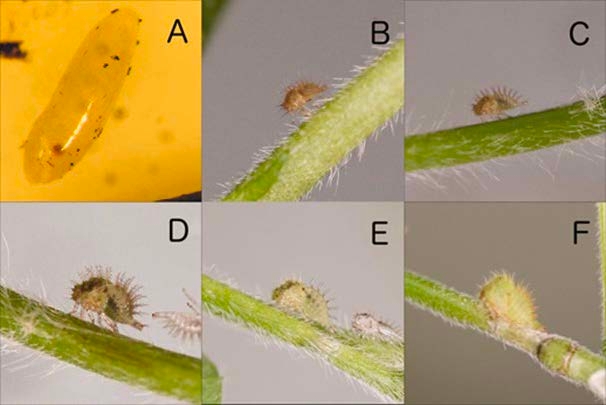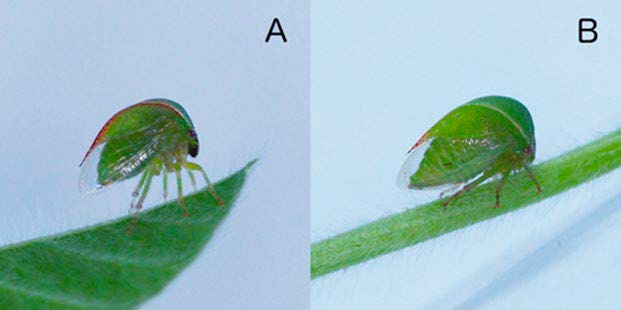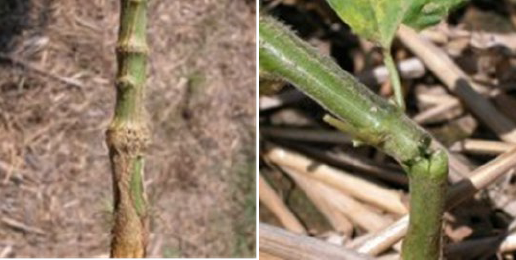Threecornered Alfalfa Hopper in Virginia Soybeans
ID
ENTO-460NP
Introduction
Threecornered alfalfa hopper, Spissistilus festinus, is a pest of soybeans that causes injury and yield loss under certain scenarios. Its range includes most US soybean producing states although damaging populations have historically been confined to the southern US (Beyer et al. 2017). Plant lodging and stand loss from this insect has occurred in soybean grown in Virginia’s piedmont since at least 2017 (Musser et al. 2020). This publication provides information on biology, scouting, plant injury, economic thresholds, and control recommendations.
Description
Eggs
Eggs are 0.9mm to 1.3mm long. The eggs are oblong, white in color, and one end of the egg is slightly larger and rougher than the other (Fig. 1) (Beyer et al. 2017).
Nymphs
Nymphs progress through five instars on average over three to ten weeks depending on temperature. The nymphs are shaped like a wedge, straw-colored, and heavily spined along their back (Fig. 1). The legs, abdomen, and eyes are white (Beyer et al. 2017).

Adults
Adults maintain the same wedge shape as the nymphs and are green. Adults range in size from 6-6.5mm. Adult females are larger than males, and males have a red/orange stripe running along its top (Fig. 2) (Beyer et al. 2017).

Ecology and Feeding Injury to Soybean
Threecornered alfalfa hopper has multiple generations per year depending on host availability and climate. Adults overwinter in grass and other vegetation and eggs overwinter inside plant tissue. Nymphs and adults will migrate into fields from vegetation and weeds on the edges of crop fields in late spring and early summer. Threecornered alfalfa hopper prefer legumes such as soybeans, cowpea, alfalfa, and sweet clover (Reisig 2021).
Females lay eggs in the base of the main stem early in the growing season or in the terminal and nodes as the growing season progresses. Adults have wings and are highly mobile. In Virginia, there are two to three generations per year (Beyer et al. 2017).
Threecornered alfalfa hopper has piercing-sucking mouthparts and feeds on phloem in the stem of plants less than 30 cm tall. Prolonged feeding may result in plant death or a girdle that can cause the plant stem to break before harvest (Fig. 3). Girdling can cause the plant stem to weaken and break during windy conditions. Additionally, girdling restricts the transport of nutrients and can lower grain yield on affected plants (Reisig 2021). Girdling of additional structures (e.g. petioles and peduncles) do not cause yield loss.

Scouting
Sampling methods for nymphs and adults are difficult and time-consuming when plants are small (i.e., sweep netting technique for plants <15 cm tall requires some skill, and visual observations are time-consuming and require careful attention). Adult activity is determined by time of day and temperature; thus, their presence may be over- or underestimated by crop scouts. Virginia soybean is planted at two different times, full-season (May) and following harvest of small grains (June). It is possible that risk of injury is higher during different periods (Stewart et. al 2017).
Beat cloths and sweep nets can be used for scouting when plants are sufficiently large. Adults can move very quickly and are ideally sampled using a sweep net. Because only young plants are susceptible to injury, scouting needs to occur prior to the V12 soybean growth stage (Beyer et al. 2017).
Economic Thresholds and Control Recommendations Early-season injury from threecornered alfalfa hopper is more common in no-till fields following cover crops and/or wheat. Higher risk fields generally include those with high organic matter. Neonicotinoid seed treatments may provide some protection, but this is dependent on growing conditions, field size, and overall insect pressure. Early-season insecticides, including seed treatments, may increase slug populations. Good agronomic practices including burning down cover crops three to four weeks before planting, using high seeding rates, and ensuring good plant stands will minimize damage. There is no evidence of economic damage from feeding on plants taller than 12 inches. Treatment is recommended when 10% or more of plants are infested. Refer to Table 1 below for chemical control recommendations.
| Insecticide (formulation) | Amount active ingredient per acre | Amount product per acre | Time limits: days before harvest | Remarks |
|---|---|---|---|---|
| Acephate (Orthene 97) | 0.75-1.0 lb | 0.75-1.0 lb | 14 | Do not exceed more than 1.5 lbs./A per season. Can flare mites in hot/dry conditions. |
| Clothianidin (Belay) | 0.05-0.1 lb | 3-6 fl oz | 21 | Do not apply in fields using a neonicotinoid seed treatment within 45 days of planting. |
| Pyrethoids – beta-cyfluthrin, bifenthrin, esfenvalerate, lambda-cyhalothrin, zeta- cypermethrin (various generic and non-generic products) | Varies by product | Varies by product | Varies by product | Follow all labeled rates and instructions. |
Summary
Threecornered alfalfa hopper can cause injury to young soybean plants if they are not controlled. As with any pest, a healthy stand of vigorous plants will minimize economic damage. Scouting early to check for insect presence as well as visual plant injury or stand loss can provide time to apply insecticides if needed. Burndown of weeds and cover crops prior to planting is highly encouraged.
References
Beyer, B. A., Srinivasan, R., Roberts, P. M., & Abney, M. R. (2017). Biology and Management of the Threecornered Alfalfa Hopper (Hemiptera: Membracidae) in Alfalfa, Soybean, and Peanut. Journal of Integrated Pest Management, 8(1). https://doi.org/https://doi.org/10.1093/jipm/pmx003
Musser, F., A. Catchot, S. Conley, J. Davis, C. Difonzo, J. Greene, G. Lorenz, D. Owens, D. Reisig, P. Roberts, T. Royer, N. Seiter, R. Smith, S. Stewart, S. Taylor, K. Tilmon, R. Villanueva, and M. Way. 2020. 2019 Soybean Insect Losses in the United States. Midsouth Entomologist. 13. 1-23.
Reisig, D. (2021, March). Threecornered Alfalfa Hopper. https://soybeans.ces.ncsu.edu/three-cornered-alfalfa-hopper/.
Stewart, A. S., & Stewart, S. (2017, June 14). Threecornered Alfalfa Hoppers in Soybean. UT Crops News. https://news.utcrops.com/2017/06/threecornered-alfalfa-hoppers-in-soybean-2/.
Funded by the Virginia Soybean Board and the Southern IPM Center. The Southern IPM Center is funded by USDA National Institute of Food and Agriculture Crop Protection and Pest Management Regional Coordination Program (Agreement No. 2018-70006-28884)
Virginia Cooperative Extension materials are available for public use, reprint, or citation without further permission, provided the use includes credit to the author and to Virginia Cooperative Extension, Virginia Tech, and Virginia State University.
Virginia Cooperative Extension is a partnership of Virginia Tech, Virginia State University, the U.S. Department of Agriculture (USDA), and local governments, and is an equal opportunity employer. For the full non-discrimination statement, please visit ext.vt.edu/accessibility.
Publication Date
November 22, 2021



